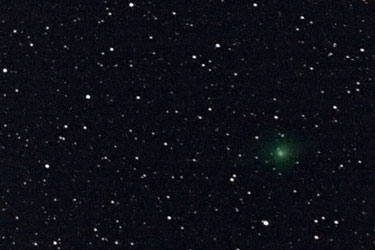Comet Guy from Down Under
He most likely inherited fascination for comets from his grandmother, who spotted Halley´s comet at two returns. No wonder he dreamed about discovering his own one. And it happened. Sungrazing comets brought him wider recognition even twice. Before all else, when he was the first amateur to discover new Sungrazing comets in images from a spacecraft in 1999. Recently he added the ground-based discovery of another Kreutz comet, C/2011 W3. Comet Guy from Down Under,Terry Lovejoy.
Comet Guy is your nickname from community website and forum Ice in Space, dedicated to amateur astronomy in Australia and New Zealand. Behind this informal name, we can find a devoted astronomer and a real comet discoverer. Nevertheless you have an ordinary profession. Could you tell us what is your day time job?
I am IT Infrastructure engineer for an Education Institution. I am responsible for a small team of IT engineers who provide operational and project support for the organisation's IT servers and storage (about 600 servers all up).
How did you "discover" astronomy?
I discovered astronomy sometime around mid 1970's when my father showed me the planets through a 60mm Unitron refractor. I also saw a couple of Solar Eclipses which help foster my interest. My interest about comets probably stemmed from my late Grandmother's account of Comet Halley in 1910 (she also saw Halley in 1986). During the late 1970's it was difficult to get prompt notification of comet's and it was frustrating to read about Bright comets several months after they had gone. It wasn't until late 1980 that I was able to spot 2 periodic comets Tuttle and Stephan-Oterma. I was fascinated by the fact that I could watch them move and that they were relatively bright compared to most deep sky objects.

Foto: J. Dunphy
As you mentioned, you are interested in astronomy since your childhood. Have you ever thouhgt of being a professional astronomer and to study astronomy?
I have thought about this at times but decided against as I wanted a career where there was always plentiful opportunities. Additionally, as what I do is a passion I have always wondered whether the enjoyment would be tempered from work pressures.
Your passion for comets grew stronger after you followed comet Tuttle in winter 1980, which reached of almost 7 mag and so it was an easy target for small telescopes. What kind of telescope did you use for its observation?
It was an 8" F6 reflector on an equatorial mount. I used to use an old 25mm Unitron Kellner that gave me 50x power and would reach mag 12 comets.
Can you recall your really first attempt to hunt for a new comet?
Actually, I didn't seriously search for comets until the SOHO discoveries in 1999. But I did try some sweeps using an 8"f6 reflector at 50 magnification in the mid 1980's. What I did do is generate some Kreutz comet search charts sometime during the late 1980's for the now defunct Australian Comet Section. Interest in Kreutz Sungrazing comets was high at the time due to the spate of discoveries from the Solwind and Solarmax satellites. It was felt that a brighter object was on the way because the appearance of these.
Spacecraft SOHO (Solar and Heliospheric Observatory) was launched in late 1995 for observing the Sun directly from the space. At that time, nobody expected that it would become the most successful comet discoverer in history with more than 2100 dicoveries to date. The new era in comet hunting was kicked off by you in summer of 1999. How did you actually learn about the SOHO search?
The SOHO search was inspired by the fact that SOHO were publishing images online from 1996 when C/1996B2 (Hyakutake) passed through the field of view. I started to search around mid-1999 and quickly found a couple of comets. Suprisingly nobody outside of SOHO was looking at the time!
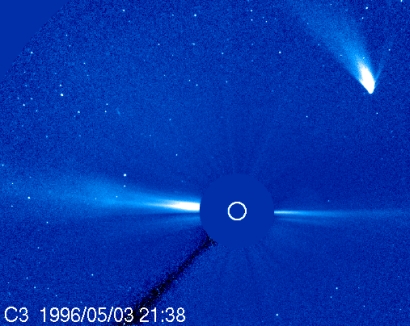
Foto: SOHO
You became a pioneer in SOHO comet hunting. During few weeks in Summer of 1999 you have found 4 sungrazing comets (SOHO-74, 75, 80 and 84) and being the first amateur to do so, you inspired many others. However after you have found 11 SOHO comets, you stopped your quest. Why?
There was increasing competition and I found it hard to get a discovery because people were submitting claims based on 3 positions or less. This resulted in a huge number of false alarms, which means a lot of extra work for people and I never felt comfortable about just submitting a claim. I see these days the discoveries are regulated by the more experienced SOHO hunters so it appears that there is now a very good solution in place. Many of these people have volunteered a vast amount of their spare time and have made a great contribution to cometary science.
Two years earlier, in 1997, you travelled thousands miles to see a bright comet. Comet Hale-Bopp was one of the brightest comets in the 90´s. Unfortunatelly, its visibility from Australia was rather poor, so you crossed the Pacific Ocean to observe it under better conditions from the USA. Did this trip meet your expectations?
Yes indeed, I had a great time. Comet Hale-Bopp was an amazing comet, especially in binoculars, and conspicuous to the naked eye even from the cities.
Was it your only astronomical journey abroad?
Yes. This was such an exceptionally rare event that I could not miss it.
Many astronomers living in the Europe dream about visiting Australia and experience the wonders of the southern skies with their own eyes. For you it is granted. Is the northern sky similarly attractive to you?
There is some envy the other way! Objects such as M51 and M31 sit very low in Australia and I really enjoyed my view of these objects when they were high overhead. Also it is a thrill to see Ursa Major and Ursa Minor which are too far north to be seen well (or seen at all) from Australia.
What places of astronomical interest would you recommend to visitors of Australia not to miss?
I would strongly recommend a visit to one of the astro events (Astrofest, Lostock for example) to get the chance to view the southern objects from dark skies through various telescopes. Apart from that Coonabarabran appears to be a bit of an astronomers paradise with Siding Springs and organised accommodation catering for amateur astronomers.
You got in touch with CCD technology back in 1994 and later you built your own cameras for astrophotography. You realized that there is a new powerful tool for astrophotography and for comet hunt as well, but the right time had not yet come …
I really had to wait for technology to become available at reasonable price. I felt CCD type technology was necessary for the type of sensitivity needed and I was unhappy using film because of the number of negatives I would need to process. One problem with CCD's was even the small format sensors were expensive, and I just didn't have the funds.

You not only recognized the power of DSLR, but also solved the problem with built-in red and infrared filters. Removing those filters, the camera became a highly useful instrument for astrophotography. When you described how to modify a camera, many astronomers started to follow your way. Finally you decided for a modified DSLR camera instead of classical CCD camera. When was it?
When the Canon 300D was released, finally a large format sensor was available at a reasonable price. Although colour and uncooled, it showed a lot of promise for comet hunting.
You live in Thornlands, suburb area of Brisbane. On the list of MPC observatory codes one can find E27 Thornlands. I think it´s not a coincidence and it is your observation place. When did you received this code?
Actually I was given the code after making pre-perihelion observations of Comet C/2004 F4 (Bradfield).
It was in April 2004, a month before you started your comet survey program, when you confirmed a comet of legendary Wiliam Bradfield. You proved the feasibility of devised technique to yourself. How did you remember this time?
It was from pure chance. I got a call from Colin Drescher who was in Hobart at the time and the comet people were talking about a possible comet Bill Bradfield that had not been confirmed.
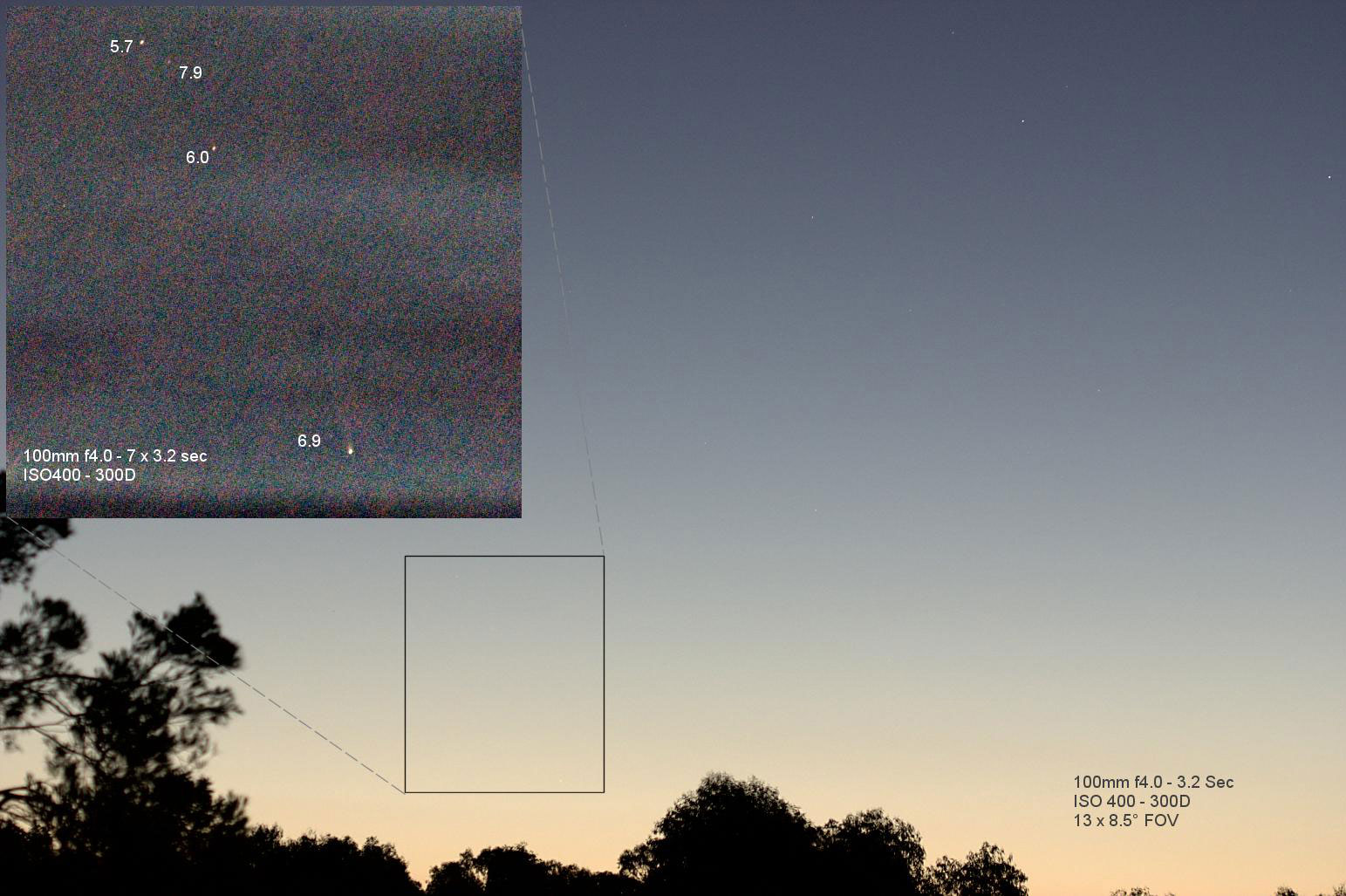
Foto: T. Lovejoy
That night I climbed up onto the top of my roof with a tripod and newly acquired 300D + telephoto lens. Made some stacked images then to my suprise got an image of the comet! I could not see anything in 15 x 80 binoculars. Luckily we had 3 consecutive clear nights and I secured enough images so that the comet's orbit could be computed and the comet was announced as C/2004 F4.
I did however intend to perform comet hunting somewhat before this and already knew the potential based on images I was seeing from amateurs with the Canon 10D.
You launched your survey work and after about 1400 dedicated hours of imaging you caught your first comet - C/2007 E2 Lovejoy in March 2007. What was your first thought after you had realized that you finally spotted the so much desired icy wanderer?
I do not keep logs of time spent searching, but it was a lot and 1400 hours was an estimate. When I came across 2007 E2 I felt "butterflies" inside and it was difficult to remain composed! My recommendation to anyone is to have a written plan on what to do when announcing a comet. You really need a second followup night, before you start contacting others - although in this case the object was obvious in all images and moving in a consistent uniform motion so I had contacted a couple of people with just one night of observations.
Only two months had passed and you found your second comet C/2007 K5 on 26. May, 2007. It happened to be almost on 2nd anniversary of the start of your survey. Did you feel the same way as in March?
The excitement was definitely less for 2007 K5 as I was already acclimatised to the comet discovery process just 2 months earlier. 2011 W3 was however as exciting as the first since it had been 4 1/2 years since the last discovery!
Two modified digital cameras, Canon 300D and Canon 350D mounted on the tripod resulted in discovery of two comets in 2007. Two years of regular hunt had passed, when you decided for an upgrade. What was the reason behind this change?
It was simply to improve sensitivity by going to a monochrome camera and a faster optical system. Also with the cooled camera calibration results in cleaner and smoother images, making object detection easier. One advantage of a colour camera however is that comets can often be easily recognised by their distinctive blue/green hue. Also I use a GOTO system which also provides more flexibility in how I search.
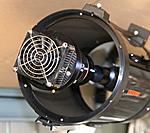
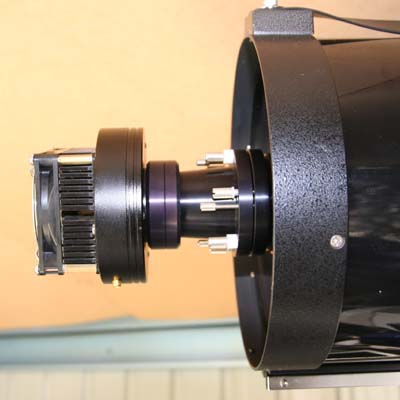
Foto: T. Lovejoy
Your recent setup is a C8 Schmidt-Cassegrain telescope adapted with HyperStar multiply lens corrector and QHY9 CCD camera. If you compare both setups, what is the outcome for the field of view, limited magnitude and sky coverage?
Because I now have a GOTO mount I can now move in Declination and Right Ascension, whereas before I could only move in Right Ascension. With the QHY9 I can reach the same magnitude with less than a quarter of the exposure I could with the 350D. Additionally, the Hyperstar is far more sensitive than the 200mm f2.8 lenses. The net result is probably a magnitude extra reach for the same area covered to my old setup.

Foto: T. Lovejoy
During one night you capture more than 200 fields images. How are you catching up with analysing the images in the morning, when you are supposed to be at work at 9 a.m. ?
I typically kick off the processing images before work, so they are sitting on my computer to be examined when I get home in the evening.
Back in non-computerized era it required several hours to analyze and measure images. Nowadays, few clicks on the mouse do the same, although it is not a matter of few minutes. Can you describe the imaging processing step?
Images are processed using IRIS 5.59 using a batch script that is generated from the same program that controls the telescope and image acquisition. Processing includes calibration and registration. I do not astrometrically solve the image unless there is something in the image. I still manually search the images which takes at most 60 seconds each. I have yet to find automated detection software that can exceed or even match the ability for finding comets, although there are amateurs working on it and I'll continue to streamline this process.
You had worked hard for almost 2 years with new instrument until you found your third comet - C/2011 W3. A Hungarian proverb says "Patience brings roses", in your case the reward was a very special comet a Sungrazer. Although, first considered it to be a reflection ...
Yes agree, although I think the weather patterns were quite poor the last few years and there were relatively few comets to discover.
Did you hope deep inside that this comet would behave differently as most SOHO comets and would survive its approach to the Sun?
Yes, I secretly hoped the comet would survive even though I didn't believe it would.
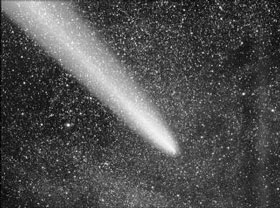
Have you ever thought that the comet would evolve to such a magnificent shape?
If it were to survive, I thought we just see a faint tail remnant. What we saw was beyond what I had expected!
You spotted it first on CCD image, then caught it visually in your DOB few days later, followed its path on SOHO images and after its suprisingly survival you observed it by naked eyes. Which sight of C/2011 W3 pleased you the most?
I wanted to see the comet with my own eyes, so the observation with the Dob would have satisfied me if the comet had not survived. But because it became quite spectacular after perihelion there is no doubt the view on December 23 was the most pleasing.
You had made a ground based discovery of a Sungrazer in late November and the Great Christmas comet of 2011 offered the most thrilling month for astronomers. As Christmas was approaching ,, many of us were looking forward to seeing never and more stunning pictures of the comet each coming mornig ...
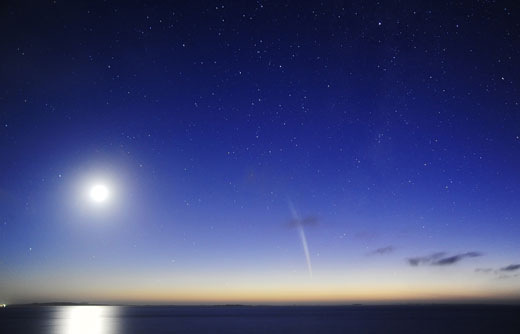
Foto: P. Haese
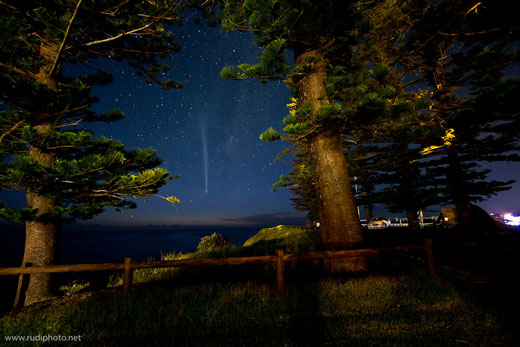
Foto: R. Vavra
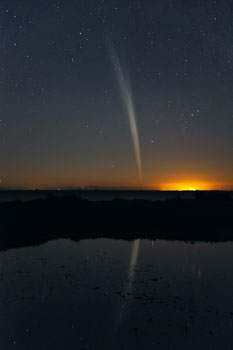
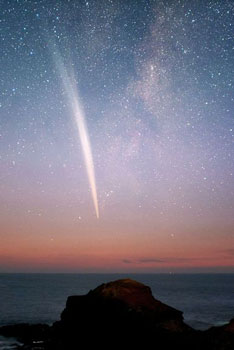
Foto: C. Legg Foto: A. Cherney
Comet Lovejoy (C/2011 W3) rising over Western Australia (21-12-2011)
from Colin Legg on Vimeo.
Do you have favourite astronomy related quote?
There is quote from Lewis Swift, one of the famous comet hunters of the 1800's that states "You can't find comets sleeping in bed". I find it funny that at least 2 comet discoveries were made while I was actually asleep in bed!
Which comets do you mean?
C/2007 E2 and C/2011 W3C.
Czech amateur astronomers uses expression "7 pearls of astronomy" for most spectacular astronomical events they wish to experience. By this they mean, total solar eclipse, lunar eclipse, northern lights, transit of Venus, very bright comet, meteor storm and supernovae explosion. What would be your 7 pearls in astronomy?
Total Solar Eclipse, Bright aurora, Meteor storm , great comet, Moon through good telescope, Saturn through good telescope and Total Lunar Eclipse in that order!
Are you looking forward to watching the total solar eclipse in Cairns next November?
Yes indeed, I will be in Cairns.


